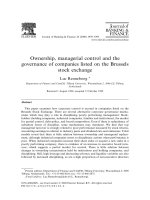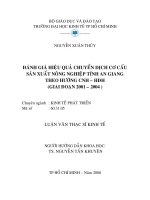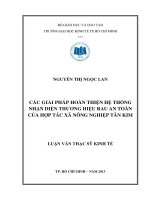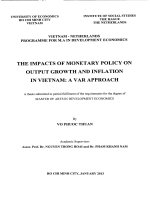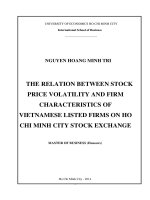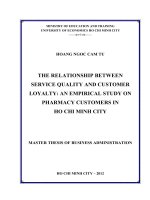Corporate governance and financial performance an analysis of companies listed in viet nams stock exchange , luận văn thạc sĩ
Bạn đang xem bản rút gọn của tài liệu. Xem và tải ngay bản đầy đủ của tài liệu tại đây (350.75 KB, 66 trang )
UNIVERSITY OF ECONOMICS HO CHI MINH CITY
International School of Business
------------------------------
HỒ NGỌC TRÂM
CORPORATE GOVERNANCE AND FINANCIAL
PERFORMANCE - AN ANALYSIS OF COMPANIES LISTED IN
VIET NAM’S STOCK EXCHANGE
MASTER OF BUSINESS (Honours)
Ho Chi Minh City – Year 2013
i
UNIVERSITY OF ECONOMICS HO CHI MINH CITY
International School of Business
------------------------------
Hồ Ngọc Trâm
CORPORATE GOVERNANCE AND FINANCIAL
PERFORMANCE - AN ANALYSIS OF COMPANIES LISTED IN
VIET NAM’S STOCK EXCHANGE
ID: 60340102
MASTER OF BUSINESS (Honours)
SUPERVISOR: Dr. Phạm Quốc Hùng
Ho Chi Minh City – Year 2013
ii
1
ACKNOWLEDGEMENT
First of all I would like to thank Dr. Hung who has brought me this far and providing
me with strength, knowledge and vitality that has helped me to make this research
work a reality.
Secondly, I would wish to thank my family for moral and financial support,
encouragement and their understanding when I was not there for them during the
project period; I wouldn’t have made it this far without them.
2
COPYRIGHT STATEMENT
This copy of the thesis has been supplied on condition that anyone who consults it is
understood to recognize that its copyright rests with its author and that no quotation
from the thesis and no information derived from it may be published without the
author’s prior consent.
© Ho Ngoc Tram / ISB-MBUS/2010-2012
3
ABSTRACT
Corporate governance is considered to have significant implications for the growth
prospects of an economy. Good corporate governance practices are regarded as
important in reducing risk for investors, attracting investment capital and improving
the performance of companies. Numerous studies have considered the implications of
corporate governance structures on company performance. Although the existing
literature is not unanimous in its conclusions, the weight of opinion is that there is a
significant relationship between governance structures and firm performance. The aim
of this research is to study the effect, if any, of corporate governance structures,
particularly board size, CEO duality and board structure is based on proportion
independent director on the performance of selected companies listed in Viet Nam’s
Stock Exchange.
Using samples of companies listed in Viet Nam Stock Exchange, this research aims to
examine the relationship between board size, CEO duality and the proportion of
independent directors on firm performance as measured by return on assets (ROA) and
return on equity (ROE), using statistical techniques. Results show that there is
significant relationship between corporate governance structures and firm’s financial
performance.
Key words: Return on Assets, Return on Equity, CEO Duality, Independent Directors,
Board size.
4
TABLE OF CONTENTS
Abstract
Chapter 1: Introduction
1.1
Research background............................................................................................................... 08
1.2
Statement of problem............................................................................................................... 09
1.3
Research objective..................................................................................................................... 09
1.4
Scope of this research.............................................................................................................. 10
1.5
Research method........................................................................................................................ 10
1.6
Research structure..................................................................................................................... 10
Chapter 2: Literature Review and Hypotheses
2.1
Introduction.................................................................................................................................. 11
2.2
Literature Review...................................................................................................................... 11
2.2.1 Corporate Governance.............................................................................................................. 11
2.2.2 CEO Duality................................................................................................................................. 17
2.2.3 Independent Directors............................................................................................................... 18
2.2.4 Board size...................................................................................................................................... 21
2.2.5 Financial performance.............................................................................................................. 22
2.3
Hypotheses development........................................................................................................ 24
5
Chapter 3: Research Methodology
3.1
Introduction.................................................................................................................................. 29
3.2
Research design.......................................................................................................................... 29
3.3
Measurement scale.................................................................................................................... 31
3.4
Target population....................................................................................................................... 32
3.5
Sample............................................................................................................................................ 32
3.6
Data collection............................................................................................................................ 33
3.7
Data screening............................................................................................................................. 34
3.8
Analysis......................................................................................................................................... 34
3.8.1 Correlation analysis................................................................................................................... 34
3.8.2 Multiple regressions................................................................................................................... 35
3.8.3 Analysis of variances................................................................................................................. 37
3.9
Summary....................................................................................................................................... 38
Chapter 4: Results
4.1
Introduction.................................................................................................................................. 38
4.2
Descriptive statistic................................................................................................................... 38
4.3
Correlation analysis.................................................................................................................. 40
4.4
Multiple regressions.................................................................................................................. 40
6
4.5
Independent sample test.......................................................................................................... 44
4.6
Analysis of variances............................................................................................................... 45
4.7
Further analysis.......................................................................................................................... 46
Chapter 5: Conclusion and Recommendations
5.1
Introduction.................................................................................................................................. 47
5.2
Conclusion.................................................................................................................................... 47
5.3
Limitation..................................................................................................................................... 49
5.4
Recommendation....................................................................................................................... 49
References
Appendix
7
LIST OF TABLES
Table 1: List of firms
Table 2: Result of correlation between independent variables and dependent variables
Table 3: Result of regression for independent variables with ROA
Table 4: Result of regression for independent variables with ROE
Table 5: Results of descriptive statistic of each variable
Table 6: Results of descriptive statistic of each group in variables with ROA
Table 7: Results of descriptive statistic of each group in variables with ROE
Table 8: Model summaryb
Table 9: Anovab
Table 10: Summary of Regression results
Table 11: Results of Independent sample test (D)
Table 12: Results of Test of Homogeneity of variances (ID)
Table 13: Results of Analysis of variances (ID)
Table 14: Results of Multiple comparisons (ID)
Table 15: Results of Test of Homogeneity of variances (BS)
Table 16: Results of Analysis of variances (BS)
Table 17: Results of Multiple comparisons (BS)
Table 18: Results of descriptive statistic (CEO non-duality and NED 40-82)
Table 19: Results of Independent sample test (CEO non-duality and NED 40-82)
8
CHAPTER I: INTRODUCTION
1.1
Research background
In today’s global business environment characterized by an increased competition, the
effectiveness of corporate governance in protecting shareholders’ interests has become
more vital than ever. Especially, corporate governance deals with the ways in which
suppliers of finance to corporations assure themselves of getting a return on their
investment. The term corporate governance basically represents a set of mechanisms
by which investors protect themselves against expropriation by both managers and
controlling shareholders.
Corporate governance is the system by which corporations are directed and controlled.
The corporate governance structure specifies the distribution of rights and
responsibilities among different participants in the corporation such as; boards,
managers, shareholders and other stakeholders and spells out the rules and procedures
and also decision making assistance on corporate affairs. By doing this, it also provides
the structure through which the company objectives are set and the means of obtaining
those objectives and examining the value and the performance of the firms. The
relative effectiveness of corporate governance has a profound effect on how well a
business performs.
Performance, which shows if the resources of the firm are used efficiently to fulfill the
goals of the firm, is crucial in evaluating the overall success of the firm. For
performance evaluation firms employ both financial and nonfinancial performance
criteria. Financial performance measures are the starting point for most organizations’
performance measures systems; such as ROA (Return on Assets) and ROE (Return on
Equity) are financial performance measures that are most frequently used at academic
research.
9
1.2
Statement of problem
The International Research Journal of Finance and Economics - Issue 50 (2010) 8 term
corporate governance has been identified to mean different things to different people.
Corporate governance has become an issue of global significance. The improvement of
corporate governance practices is widely recognized as one of the essential elements in
strengthening the foundation for the long-term economic performance of countries and
corporations. The term corporate governance relates to how corporations, firms,
organizations etc. are owned, managed and controlled. This is an issue which has been
the subject of much debate in recent years. However, to understand the reasons for the
recent upsurge in the interest for these issues and the particular focus that the debates
typically have had, one must look more closely at the particular background for these
debates.
Over the last two decades, Vietnam has emerged as one of Asia’s fastest growing
economies and most attractive locations for foreign investment. However, concerns
attributed to corporate governance have evolved along with Vietnam’s growth.
Corporate governance is still a new concept in Vietnam, and the corporate governance
framework is in the early stage of development process. According to the recent IFCMPDF survey in Vietnam, only 23% of the companies surveyed understand the basic
concept of corporate governance, and there remains the confusion between
“governance” and “management” between company directors. Thus, the importance of
corporate governance has still not been focused on improvement of firm performance.
1.3
Research objective
This study focuses on the relationship between corporate governance and performance
in organizations of Viet Nam. In this paper performance of the firm will be analyzed
through corporate governance. Because it is said by different researchers that
10
performance of the firms is affected by practicing good corporate governance policies.
As we all are well aware of it that corporate governance is at its initial stage in Viet
Nam, so proper application and practice of corporate governance is not present at this
moment in Viet Nam. So, the aim behind this effort is aware the people of Viet Nam
about the benefits of good corporate governance so that they can avail all opportunities
to compete not only at national level but also at international level.
1.4
Scope of this research
This research focuses on firms that are listed in Viet Nam’s stock exchange and firms
which have annual report in 2011.
1.5
Research method
This research method based on market data from website: www.cophieu68.com.vn and
something like that. The SPSS software package was used to analyze the effect of
corporate governance on firm performance of the top 199 listed companies.
1.6
Research structure
Chapter 1: Introduction. Research introducing will give the overview information of
the research.
Chapter 2: Literature review and hypotheses: Literature review will review the
theoretical of corporate governance, the important role of independent director, CEO
duality and board size and review the theoretical relationship between them.
Furthermore, this chapter will show information about the model and hypothesis will
be tested in this research.
Chapter 3: Research methodology: This chapter present research design, measurement
scale, target population, sample, data collection and method analysis.
11
Chapter 4: Results: This chapter show result of data analysis process, data summary to
provide the information of the sample, the multiple regression and correlation
analysis were used to test the relationship of corporate governance and firm
performance. Independent sample test and Anova technique were used to test for
significant difference of groups in the same independent variable.
Chapter 5: Conclusion and Recommendations. Based on results of research, this
chapter will explain how corporate governance have a significant positive or negative
effect on firm performance and also limitations of this research and imply how to apply
this research correctly also how to develop this research further.
CHAPTER 2: LITERATURE REVIEW AND HYPOTHESES
2.1
Introduction
This chapter reviews the theoretical of corporate governance, the important role of
independent director, CEO duality and board size and review the theoretical
relationship between them. Furthermore, this chapter will show information about the
model and hypothesis will be tested in this research.
2.2
Literature review
2.2.1
Corporate Governance
In the past, there are many deep studies on the subject, it is important to define the
concept of corporate governance. The vast amount of literature available on the subject
ensures that there exist innumerable definitions of corporate governance. To get a fair
view on the subject it would be prudent to give definition of corporate governance.
Corporate governance involves a set of relationships amongst the company’s
management, its board of directors, its shareholders, its auditors and other
12
stakeholders. These relationships, which involve various rules and incentives, provide
the structure through which the objectives of the company are set, and the means of
attaining these objectives as well as monitoring performance are determined. Thus, the
key aspects of good corporate governance include transparency of corporate structures
and operations; the accountability of managers and the boards to shareholders; and
corporate responsibility towards stakeholders. While corporate governance essentially
lays down the framework for creating long-term trust between companies and the
external providers of capital, it would be wrong to think that the importance of
corporate governance lies solely in better access of finance.
In general, corporate governance is considered as having significant implications for
the growth prospects of an economy, because best practice corporate governance
reduces risks for investors, attracts investment capital and improves the performance of
companies (Spanos 2005). The effective corporate governance is considered as
ensuring corporate accountability, enhancing the reliability and quality of financial
information, and therefore enhancing the integrity and efficiency of capital markets,
which in turn will improve investor confidence (Rezaee 2009).
Companies around the world are realizing that better corporate governance adds
considerable value to their operational performance:
-
It improves strategic thinking at the top by inducting independent directors who
bring a wealth of experience, and a host of new ideas.
-
It rationalizes the management and monitoring of risk that a firm faces globally.
-
It limits the liability of top management and directors, by carefully articulating
the decision making process.
-
It assures the integrity of financial reports.
13
-
It has long term reputational effects among key stakeholders, both internally and
externally.
At the policy level, there is a strong effort in designing corporate governance policies
that enhance monitoring the management and transparency. The policies give
shareholders some mechanisms to control the Board of Directors. They can vote for the
Board of Directors, Board of Supervisors, and major strategic decisions of the
companies. However, whether the arrangements work in practice is interesting to
investigate.
Good Corporate Governance is of paramount importance in all organizations regardless
of their industry, size or level of growth. The main corporate governance themes that are
currently receiving attention are adequately separating management from the board to
ensure that the board is directing and supervising management, including separating the
chairperson and chief executive roles; ensuring that the board has an effective mix of
independent and non-independent directors.
Good Corporate governance aims at increasing profitability and efficiency of
organizations and their enhanced ability to create wealth for shareholders, increased
employment opportunities with better terms for workers and benefits to stakeholders.
Indicators of Good Corporate governance identified in the study include independent
directors, independence of committees, board size, split chairman/CEO roles and the
board meetings. Thus, the main tasks of corporate governance refer to: assuring
corporate efficiency and mitigating arising conflicts providing for transparency and
legitimacy of corporate activity, lowering risk for investments and providing high
returns for investors and delivering framework for managerial accountability.
14
Corporate governance in Viet Nam:
Corporate governance is of much interest for both professionals and academics,
particularly following a collapse of many large companies in the U.S. and U.K such as
Worldcom, Enrol,... In Asia, it is widely believed that weak corporate governance is one
of the main reasons for economic crisis in 1997. In Vietnam, corporate governance is
now becoming hot topic in the top government official discussion, particularly since the
government commits to accelerate the state sector reform.
Corporate governance is still alien to Vietnam. According to Freeman and Nguyen
(2004), the concept of corporate governance is not yet established in Vietnam. In fact,
the Vietnamese equivalent term of “Corporate governance” which is broadly similar to
“Administration” is confusing and has yet to take hold as a popular term. In Vietnam,
corporate governance principles have been incorporated into corporate law systems.
The Vietnamese government issues a number of laws and regulations pertaining to
listed companies. Current regulations concerning corporate governance for listed
companies and listed companies can be found in the Corporate Law (1999), Degree 64
CP (2002) of the government on equitization of the SOEs, and Degree 144 CP (2003) of
the government on stocks and the stock market.
Enterprise law and Joint Stock Companies in Viet Nam:
-
Must have at least 3 shareholders but no maximum
-
Ownership is divided into ordinary shares and several types of classes of
preferential shares
-
May issue securities for fund raising and go listed if satisfying listing
requirements
15
-
Each shareholder’s liability is limited to the value of its shares held in the
company
-
Management structure: + General Shareholders’ Meeting (GSM)
+ Board of Management / Board of Directors
+ General Director / Director (CEO)
+ Inspection Committee if there are more than 10
individual shareholders or a corporate shareholder holds more than 50% shares. Its
members are from 3 to 5.
As it can be seen in the following regulations, corporate governance model in Vietnam
is broadly similar to German corporate governance model in that it has two tier boards:
Board of Directors and Supervisory Board and Board. These regulations can be briefly
described as follows:
-
Shareholders’ meeting is the highest decision maker of listed companies.
-
Shareholders’ meeting votes for (or against) member of the Board of Directors
and Board of Supervisors (in case the company has more than 10 shareholders). The
board of directors should not have more than 11 members. There is no regulation on
how many managers or outside shareholders should be on Board.
-
The Board of Directors appointed the CEO and other important management
positions of the companies. The CEO can be a member of Board of Governors.
-
If the company has more than 10 shareholders, it must have Board of
Supervisors. The Board of Supervisors should have from 3 to 5 members, of which at
least one member has a background in accounting. Members of the Board of Directors,
CEOs, chief accountant, and their related people can not be members of the Board of
16
Supervisors. The Board of Supervisors is not required to have outside members (not
currently employees of the company).
Corporate governance requirements in Viet Nam:
The corporate governance framework should ensure the strategic guidance of the
company, the effective monitoring of management by the board, and the board’s
accountability to the company and the shareholders. For a join stock company, the
corporate management included the Board of Management the General Director /
Director (CEO), and the Inspection Committee with certain internal control function.
The Board and the Inspection Committee are subordinated to the general shareholders’
meeting and the CEO is accountable to the Board. The Board consists of no less than 3
(5 for listed companies, of which 1/3 must be non-executive members) and no more
than 11 members. Board members are elected by shareholders at general shareholders’
meeting for a term of less than 5 years.
In Vietnam, the Board has a more direct role in the activities of the company, rather than
the supervisory role in other countries, and is therefore much more influential in respect
of the day-to-day operations of the company. The Board appoints one person among its
members or an outsider to act as General Director / Director which is the legal
representative of the company (or this post may be held by the Chairman of the Board if
the charter provides otherwise).
Under the Enterprise Law 2005, directors of a company have the duties of care, loyalty
and diligence to the company and shareholders. In reality, the Boards are often
dominated by the majority shareholders, which are represented by the Chairman of the
Board or the CEO. And in general, the Inspection Committee is weak. However,
concept of non-executive and independent directors is new.
17
2.2.2
CEO Duality
There are two types of leadership structure, that is, combined leadership structure and
separated structure. It occurs if the roles of chairman and CEO are combined. The
chairman of the board is responsible for managing the board, which may include tasks
such as selecting new board members, monitoring the performance of the executive
directors and settling any conflicts which arises within the board. The CEO is
responsible for the day to day management of the company, including the
implementation of board decisions. The companies that practices CEO duality, may
have an individual who possesses too much power and might make decisions that do
not maximize shareholders wealth.
The relationship between CEO duality and firm performance is considered
neutral/insignificant in certain studies whereby there is no link between CEO duality
and firm performance (Berg and Smith 1978). No significant relationship was shown in
a different study done using Malaysian public listed companies as sample (Allen Chang
2004). Although the literature is not unanimous in its conclusions, the weight of opinion
is that there is a significant relationship between CEO duality towards firm
performance.
Even though the impact of the CEO duality on firm performance has been widely
researched, due to the conflicting nature of theoretical underpinnings that encompasses
this concept with wide variety of perspectives, determining duality-nonduality
consequences solely based on firm performance has become controversial (Boyd, 1995;
Finkelstein & D'Aveni, 1994). For instance, in one hand, agency theory, which
advocates that separation of the CEO-Chairman positions would maximize corporate
performance since the board has an unbiased authority to oversee the CEO’s functions
(Gillan, 2006; Harris & Helfat, 1998; Shleifer & Vishny, 1997), dominates the corporate
governance implications in this context. Contrary to what agency theory
18
proposes, on the other hand, referring to a broad leadership, behavioral, and
psychological standpoints, stewardship theory outlines that holding both positions by
one person would enhance firm performance with that holding two positions by one
person can monitor the firm unambiguously and can have a unique command
throughout the firm (Adams, Almeida, & Ferreira, 2005). Although the notion that the
CEO duality has significant corporate performance is extensive, yet the prior empirical
evidence on the issue is inconsistence in either theoretical application. For instance,
Boyd (1995) summarized seven prominent corporate governance studies between the
CEO duality and firm performance relationship, and realized that only two studies had
negative impact on performance whereas five showed to be positive or no significant
effect on performance. Moreover, integrating those inconsistency results, Boyd found
that the CEO duality has a weak negative relationship on firm performance. Further,
Harris and Helfat (1998) analyzed previous governance studies on the same settings and
disclosed that out of thirteen researches three only had negative effects of duality on
firm performance while ten found that either positive or no effects. Prior literature have
also supported for the CEO duality or signifies that no relationship between duality and
firm performance (Benz & Frey, 2007). Consequently, even today, determination of the
notions that the CEO duality- non duality based on corporate performance has been an
unresolved phenomenon in corporate governance researches.
2.2.3
Independent directors
Board independence is one of the key issues in corporate governance (CG). However,
there are diverse opinions about the importance of board independence. Some suggest
incentive alignments dominate CG (Demsetz, 1983; Hart, 1983) and others argue board
monitoring and advisory role are essential (Fama, 1980; Fama & Jensen, 1983).
Nevertheless, most of the corporate governance codes around the world promote board
19
independence. One important aspect of board independence is the number of
independent directors on the board of directors.
The role of independent directors on the board of directors is to effectively monitor and
control firm activities in reducing opportunistic managerial behaviors and expropriation
of firm resources (Fama and Jensen 1983). However, independent directors face
difficulties in discharging their duties as they are not directly affiliated with the
management (Weisbach 1988). There is evidence to show that independent directors are
valued for their ability to advise, to solidify business and personal relationships, and to
send a signal that the company is doing well rather than for their ability to monitor
(Mace 1986, Herman 1981). Nevertheless, a study of Singapore’s directors has
indicated that most of the respondents were of the opinion that the optimum level of
independent directorship is between 25% and 50% of the total size of the board and the
independent directors were more convinced that strong corporate governance enhanced
the board effectiveness more than executive directors (Goodwin and Seow 2000). As
such, the proportion of independent directors is identified as the other independent
variable in this study.
The Important Role of the Board of Directors:
The board of directors plays an important role in the operation of a company. It
oversees top management and is entrusted with the responsibility of monitoring and
supervising the company’s resources and operation. Therefore, the board is collectively
seen as a team of individuals with fiduciary responsibilities of leading and directing a
firm, with the primary objective of protecting the firm’s shareholders’ interests
(Abdullah 2004). There are three critical board roles such as service roles, control roles
and strategic roles (Zahra and Parce 1989).
20
Furthermore, a company’s board of directors can play an important role in determining
the kind of funding a public offering receives. If going public is your goal, the selection
of board members should be given especially careful consideration. The board of
directors serves a couple of important functions for a company that has gone public or
plans to in the near future. First, the selection of particular board members can send a
signal to investors regarding the quality of a company and the expertise behind the
scenes. A board that is composed of highly-regarded experts in a field will be viewed
much more favorably than a corporation with a board made up primarily of insiders.
Knowledgeable outside experts bring connections, expertise, and a lack of bias that
cannot be obtained with insiders.
The board of directors also serves as a powerful ally to stockholders, particularly when
a company’s CEO doesn’t own a controlling share of the corporation. In addition to
providing guidance, the board of directors may have the ability to overrule the CEO. In
some cases, it can even remove the CEO from the company. Because all major
corporate issues go through the board of directors, stockholders are wary of a company
with too many insiders on the board. Because the board of directors exists to oversee the
corporation and preserve shareholder value, it is important that your board is perceived
as objective, if not slightly biased in favor of stockholders. While appointing outsiders
is a good start, it’s also important to align the incentives of the board members with
those of the shareholders. Providing compensation to board members in the form of
company stock is an excellent way to accomplish this. If the board of directors does
well when the company does well, the board of directors will be much more inclined to
ensure that the company performs well.
21
2.2.4
Board size
The two most important functions of the board of directors are those of advertising and
monitoring (Adams and Ferriera, 2007). The advisory function involves the provision of
expert advice to the CEO and access to critical information and resources (Fama &
Jensen, 1983). This is performed by both insiders and outsiders. However, Fama &
Jensen note the importance of outside directors, who bring valuable expertise and
potentially important connections. The advantage of larger board size is the greater
collective information that the board subsequently possesses and hence larger boards
will lead to higher performance (Dalton Dalton, DR, Daily, CM, Ellstrand, AE &
Johnson, J 1998). Secondly, the board has the responsibility to monitor, discipline, and
remove ineffective management teams, to ensure that managers pursue the interests of
shareholders. Raheja (2005) argues that insiders are an important source of firm –
specific information for the board, but may have distorted objectives due to private
benefits and lack of independence from the CEO. Compared to insiders, outsiders are
more independent, providing better monitoring, but are less informed about the firm’s
activities. Furthermore, the advantage of larger board size is the greater collective
information. Therefore, board size increases, and increases in the number of nonexecutives are expected to have a more positive impact than increases in the number of
executive directors.
However, there are eventually disadvantages of large boards in the form of coordination
costs and free rider problems. Firstly, coordination and communication problems arise
because it is more difficult to arrange board meetings, reach consensus, leading to
slower and less-efficient decision-making (Jensen 1993). Secondly, board cohesiveness
is undermined because board members will be less likely to share a common purpose,
communicate with each other clearly, and reach a consensus that builds on the director
different points of view (Lipton and Lorsch, 1992). Thirdly, director free-riding
22
increases because the cost to any individual director of not exercising diligence falls in
proportion to board size (Lipton and Lorsch, 1992). Lipton and Lorsch (1992) suggest
that as board size increases beyond a certain point, these inefficiencies outweigh the
initial advantages from having more directors to draw on, leading to a lower level of
corporate performance. Lipton and Lorsch (1992) argue that a board size of eight or
nine directors is optimal, whilst Jensen (1993) argues that the optimum board size
should be around seven or eight directors.
Evidence from other countries is broadly consistent but less robust. Eisenberg,
Sundgren and Wells (1998) concluded the negative relationship between firm board size
and performance measured by return on assets (ROA) for a sample of 879 small private
firms in Finland. In other studies beside this result that find a positive relationship
between board size and firm performance. Tanna, Pasiouras and Nnadi(2008)
underscore the positive relation between board size and performance for English banks.
Belkhir (2008) finds that increasing board sizes do not undermine the firm performance
and there is a positive relationship between board size and firm performance.
2.2.5
Financial performance
Traditionally most of the managerial performance measures have been based on
financial measures of performance (Eccles, 1991; Nanni et al., 1990). Although
measuring financial performance is considered a simpler task, there is little consensus
about which measurement instrument to apply. Different accounting ratios are often
used to measure financial performance. These measures include return on assets (ROA)
and return on equity (ROE). Empirical researches use either market-based measures or
accounting-based measures to assess firm performance. Klein (1998) uses return on
assets (ROA) and return on equity (ROE) as an operating performance indicator. Brown
and Caylor (2005) use ROE and ROA as their two operating performance measures.
23
We can measure the operating performance of a firm through the ROA ratio which
shows the amount of earnings have generated from an invested capital assets (Epps &
Cereola 2008). Managers are directly responsible for the operations of the business and
therefore the utilization of the firms’ assets. Thus, ROA allows users to assess how well
a firm mechanism is in securing and motivating efficient management of the firm. In the
present study, ROA is defined as net income before interest expense for the fiscal period
divided by total assets for that same period. One of the primary reasons for operating a
corporation is to generate income for the benefit of the common stockholders (Epps &
Cereola 2008). ROE is a measure that shows an investor how much profit a company
generates from the money invested from its shareholders. In this study, ROE is defined
as the income before interest expense for the fiscal period divided by total shareholder
equity for that same period.
It is widely acclaimed that good corporate governance enhances a firm’s performance
(Byrd and Hickman, 1992; Rosenstein and Wyatt, 1990). In spite of the generally
accepted notion that effective corporate governance enhances firm performance, other
studies have reported negative relationship between corporate governance and firm
performance (Hutchinson, 2002) or have not found any relationship (Singh and
Davidson, 2003). Several explanations have been given to account for these apparent
inconsistencies. Some have argued that the problem lies in the use of either publicly
available data or survey data as these sources are generally restricted in scope. It has
also been pointed out that the nature of performance measures (i.e. restrictive use of
accounting based measures such as return on assets (ROA), return on equity (ROE),
return on capital employed (ROE) or restrictive use of market based measures (such as
market value of equities) could also contribute to this inconsistency (Gani and Jermias,
2006).
